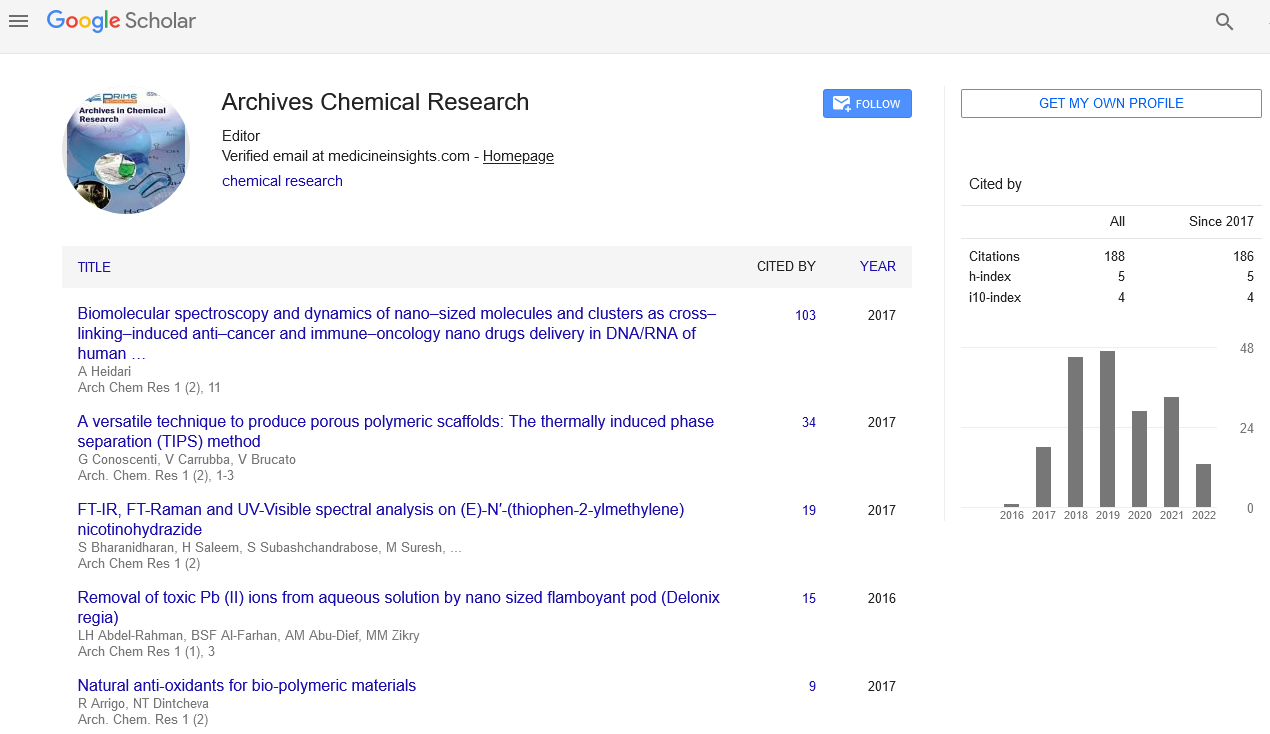Opinion - (2024) Volume 8, Issue 2
Medicinal Chemistry: The Intersection of Chemistry and Medicine
Chloe Carter*
Department of Organic Chemistry, East London University, United Kingdom
*Correspondence:
Chloe Carter,
Department of Organic Chemistry, East London University,
United Kingdom,
Email:
Received: 29-May-2024, Manuscript No. IPACRH-24-20311;
Editor assigned: 31-May-2024, Pre QC No. IPACRH-24-20311 (PQ);
Reviewed: 14-Jun-2024, QC No. IPACRH-24-20311;
Revised: 19-Jun-2024, Manuscript No. IPACRH-24-20311 (R);
Published:
26-Jun-2024, DOI: 10.35841/2572-4657.8.2.18
Introduction
Medicinal chemistry is a scientific discipline at the intersection
of chemistry and pharmacology, focusing on the design,
development, and synthesis of pharmaceutical agents. It
involves understanding the interactions between chemical
compounds and biological systems to develop new drugs that
can treat various diseases. Medicinal chemistry is essential
for the pharmaceutical industry, driving the discovery of new
therapeutic agents and advancing medical science. The roots of
medicinal chemistry trace back to ancient times when natural
products like plants and minerals were used for medicinal
purposes. The modern era of medicinal chemistry began in the
late 19th and early 20th centuries with the advent of synthetic
organic chemistry. Pioneers like Paul Ehrlich, who developed the
concept of the “magic bullet” for targeting specific pathogens,
laid the groundwork for systematic drug discovery. The
discovery of penicillin by Alexander Fleming in 1928 marked a
significant milestone, leading to the development of antibiotics
and revolutionizing medical treatment. The first step is
identifying a biological target, such as a protein or enzyme that
is involved in a disease process. This target must be validated
to ensure that modulating it will have a therapeutic effect.
High-throughput screening of large chemical libraries is used
to identify lead compounds that interact with the target. These
compounds serve as starting points for drug development.
The lead compounds are chemically modified to improve their
efficacy, selectivity, and pharmacokinetic properties. Medicinal
chemists use structure-activity relationships (SAR) to guide
the optimization process. Optimized compounds undergo
preclinical testing in cell cultures and animal models to assess
their safety, efficacy, and pharmacokinetics.
Description
Successful candidates move on to clinical trials, which are
conducted in three phases to evaluate safety, efficacy, and
dosage in humans. This process is rigorous and can take several
years to complete. After successful clinical trials, the drug is
submitted for regulatory approval to agencies like the FDA or
EMA. Upon approval, the drug can be marketed and prescribed
to patients. Molecular modelling and Computer-Aided Drug
Design (CADD) help predict the interaction of drug candidates
with biological targets, reducing the need for extensive
experimental testing. Automated systems test thousands
of compounds for biological activity, rapidly identifying
potential lead compounds. These techniques provide detailed
information about the three-dimensional structures of
biological targets and their complexes with drug candidates.
Used for the identification and quantification of compounds,
as well as studying their metabolism and degradation. The
emergence of drug-resistant strains of pathogens, particularly
in antibiotics and antiviral drugs, poses a major challenge.
Continuous development of new drugs and combination
therapies is essential to combat resistance. Many promising
drug candidates fail due to toxicity and adverse side effects.
Improving the safety profile of drugs is a critical aspect of
medicinal chemistry.
Conclusion
Tailoring drug treatments to individual patients based on their
genetic makeup and disease profiles is becoming increasingly
feasible with advances in genomics and bioinformatics.
The development of biological drugs, such as monoclonal
antibodies and gene therapies, is expanding the range of
therapeutic options. Biosimilar, which are analogous to
generic drugs but for biologics, are also gaining importance.
The principles of green chemistry are being applied to make
drug synthesis more sustainable, reducing the environmental
impact of pharmaceutical manufacturing. Medicinal chemistry
is a dynamic and essential field that drives the discovery and
development of new drugs, improving health outcomes and
quality of life. As technology and scientific understanding
advance, medicinal chemistry will continue to play a pivotal role
in addressing global health challenges and paving the way for
innovative treatments. The integration of computational tools,
personalized medicine, and sustainable practices promises to
shape the future of this vital discipline.
Citation: Carter C (2024) Medicinal Chemistry: The Intersection of Chemistry and Medicine. Arch Chem Res. 8:18.
Copyright: © 2024 Carter C. This is an open-access article distributed under the terms of the Creative Commons Attribution License, which permits unrestricted use, distribution, and reproduction in any medium, provided the original author and source are credited.

